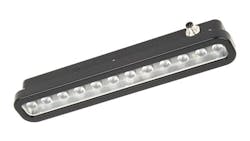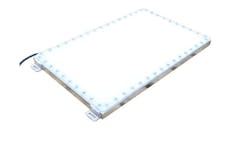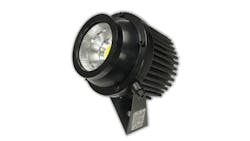Rugged Machine Vision Lighting Options Weather Harsh Environments
To survive in harsh environments, machine vision components—including lights—must be rugged.
These conditions include extreme heat or cold, moisture, dust, and shock and vibration. To help vision engineers cope with these scenarios, lighting manufacturers have developed products and techniques to withstand these environments.
Enclosures are one way to protect lights. “Traditionally, lighting for harsh environments involved placing a standard light, which would not survive the environment, into an enclosure that is rated for the environment. These enclosures need to fully enclose the light. In wet environments, they often need to be vented in a way to minimize air pressure differences to prevent fogging but also keep water out,” explains Steve Kinney, director of training, compliance, and technical solutions for Smart Vision Lights (Norton Shores, MI, USA).
Moisture and Dust
Two rating systems outline the degree of ruggedness an enclosure for a lighting product provides against ingress from solids and liquids.
For example, IP codes developed by the International Electrotechnical Commission (Geneva, Switzerland) rate the degree of protection an enclosure provides against dust and liquids. The codes include two numbers, such as IP 67, in which the first number defines the level of protection against dust and solid objects while the second relates to liquids. (See Figure 2.)
The National Electrical Manufacturers Association (Rosslyn, VA, USA) has developed a similar rating system1 that defines the types of environments in which a given enclosure can be used. The ratings address both indoor and outdoor environmental hazards such as splashing water, rain, snow, sleet, falling dirt, and windblown dust.
Lindsey Sullivan, technical marketing manager at CCS America, Inc. (Woburn, MA, USA), notes, “Machine vision lighting manufacturers tend to not offer these types of enclosures off-the-shelf. However, it doesn’t hurt to ask especially if the lighting manufacturer specializes in custom solutions. But more often, companies will build it in-house or go to a supplier who sells standard enclosures.”
However, enclosures aren’t the only option for combatting the elements. A popular option among lighting manufacturers is the washdown light.
“The benefit of this is that the light becomes more compact without the secondary environmental enclosure. Any venting, heating, or cooling to meet the environmental conditions are native to the light, increasing reliability. Ruggedized or washdown-rated lights are more expensive than their standard environment equivalents but are more cost effective than the dual cost of the light plus an external enclosure,” Kinney says.
Extreme Temperatures
Temperature extremes can also cause problems for lighting products.
In general, LEDs perform better in environments with extreme hot or cold ambient temperatures than other types of lights. “They don’t generate as much heat compared to other light sources like fluorescent lamps, and they can operate in a wide temperature and humidity range while maintaining consistent performance, typically between 0 to 40°C, with humidity of 20 to 85% RH (no condensation),” says Sullivan.
Mark Kolvites, senior technical sales manager for Metaphase Technologies (Bristol, PA, USA), says there are multiple options to address heat. “For higher ambient temperatures, active cooling is needed, and that is provided via cooling fans, air conditioning, compressed air, a vortex cooler, or even liquid cooling. Outdoor LED utilizers will include Sunshield to prevent temperature buildup caused by direct exposure to sunlight. Another way to avoid excessive internal temperatures is to only turn the LED illuminator on during image acquisition (strobing) as opposed to continuous operation (always on). Strobing can provide more intense illumination than continuous on mode, but since the light is only on for a fraction of the time, it does not produce nearly as much heat.”
Kolvites, also notes, “Just as extreme heat can damage LED light electronics, so can very extreme cold due to water vapor condensing on the surface of the components and circuit boards. This will cause corrosion, which often leads to electrical failure or shorts. Internal heating elements within the LED illuminator are a technique to reduce the effects of exposure to low temperatures. Additionally, closed loop temperature monitoring ensures the LED light is kept within a safe operating temperature range.”
Sullivan warns that “there is no real solution for extreme cold, so you need a way to maintain the operating environment at 0°C (32°F) at a minimum.”
In addition to hot and cold, large temperature differentials that occur over a short period of time are also a problem because they can lead to air condensation. Jack McKinley, head of development at TPL-Vision (La Chevrolière, France), explains that this “is why temperature changes must be kept to a minimum within any kind of enclosure. With high humidity comes a higher dew point, causing air to condense at a higher temperature. In cases where illumination must be subject to temperature shifts, the design must consider how air inside the enclosure is affected, emphasizing the importance of incorporating vents for effective air circulation.”
Food processing is an example of an industry that deploys rigorous methods to clean, including high pressure spray, hot water at 165° F or higher, and caustic cleaners—all of which are tough on lighting products used in manufacturing plants for applications such as product inspection.
“Historically, food grade washdown products or enclosures had to be made with stainless steel housings, which are expensive to manufacture. Recently, the FDA (U.S. Food and Drug Administration) has relaxed the rules to include other metals, such as aluminum, that are coated. The coatings may be the non-stick type, such as Teflon (registered mark Dupont) or can be plating such as electroless nickel. This reduces costs while increasing performance due to the better thermal properties of aluminum over stainless steel,” Kinney explains.
McKinley suggests that engineers consult a lighting product’s documentation to judge its compatibility with washdown environments and particularly caustic chemicals. “For food environments, smooth surfaces are recommended to prevent the build-up of foodstuff and facilitate easy and effective cleaning,” he notes.
Shock and Vibration
Shock and vibration are other characteristics of a harsh environment. To protect against this movement, McKinley says, “secure mounting is key.” One example is a swivel mount bracket with a ball and peen locking system. Another option, he says, is to employ ahigher level of brightness than would overwise be necessary. "Higher brightness can enhance the vision system's robustness by reducing susceptibility to vibrations and offering a larger depth of field, " he says. One way to achieve this is through an overdrive option, or high-power strobe.
Kolvites explains other techniques manufacturers use to protect against shock and vibration. One example is the “utilization of automotive grade components that can tolerate high vibration, such as soft termination capacitors. Potting, the process of filling the complete LED illuminator’s electronic assembly with a solid or gelatinous compound, provides resistance to shock and vibration, and protects against moisture and corrosive agents.
Nonetheless, Sullivan notes, “A strong enough vibration over time can loosen parts of the lights.”
No matter what the specific environmental issue is, there is one approach that helps counteract all of them. As Kolvites explains, “The best way to protect machine vision LED lights from a harsh environment is to simply keep them out of the elements by positioning the illuminator at some distance from an environmental issue. LEDs can be configured with appropriate lensing to allow them to be mounted at distance that is out of harm’s way.”
References
1. NEMA Ratings for Enclosures. NEMA. Accessed February 19, 2024. https://www.nemaenclosures.com/enclosure-ratings/nema-rated-enclosures.html
About the Author
Linda Wilson
Editor in Chief
Linda Wilson joined the team at Vision Systems Design in 2022. She has more than 25 years of experience in B2B publishing and has written for numerous publications, including Modern Healthcare, InformationWeek, Computerworld, Health Data Management, and many others. Before joining VSD, she was the senior editor at Medical Laboratory Observer, a sister publication to VSD.






